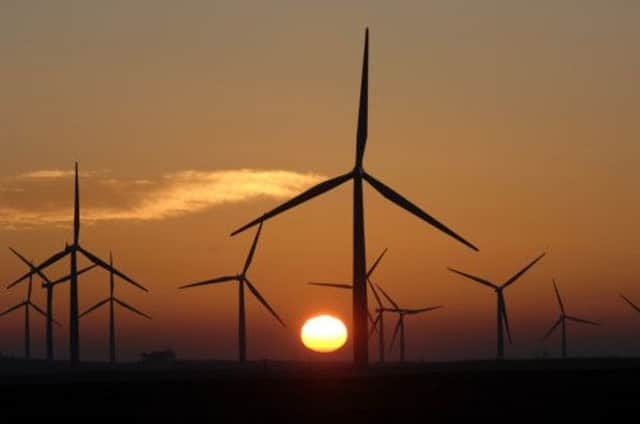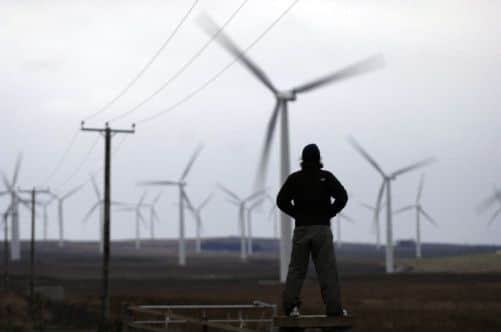Wind power for Scotland is a load of hot air


There are costs and benefits to everything in life. The costs of wind energy are high and the benefits few. Every country needs a cheap, reliable supply of electricity and wind energy is neither.
A cheap supply is needed because: money spent on expensive electricity is not available to spend on education, health and infrastructure; electricity is essential for heating and cold houses kill every winter; the price of our goods in global markets is underpinned by electricity price; and because only a vibrant, creative economy using the cheapest energy will survive in an uncertain future.
Advertisement
Hide AdAdvertisement
Hide AdOur future lies in nuclear and gas, because it is more reliable and cheaper than wind. If you want more gas-powered electricity, you burn more gas. You can’t summon up more wind.


Twice as expensive as nuclear, gas or coal
The Royal Academy of Engineering calculates that per unit of energy, onshore wind is twice as expensive as nuclear, gas or coal; offshore threefold.
Why is wind energy so expensive?
Intermittency and the low density of air are one reason. The capacity average (generated energy/installed energy) of Scottish wind farms is about 25 per cent: for nuclear or gas it is 75-90 per cent.
To match the output of a conventional power station, such as Cockenzie, requires the average output of 2000 turbines and about a 300-fold bigger land area. Large-scale landscape damage is thus implicit when wind is used.
Whereas a new gas-fired power station costs about £0.9 billion, 2000 turbines cost about £3 billion. A power station will last 40 years, a wind farm only 25 years.
But the capacity factor of wind is not stable. Professor Gordon Hughes of Edinburgh University has shown that the capacity declines to half within 15 years, requiring turbine replacement; offshore capacity declines fourfold within ten years. The consumer will carry that cost, too, in electricity price.
No matter how many wind turbines are erected, if there is no wind, there is no wind-generated electricity. Back-up from conventional power is thus inevitable and to the full extent of consumer demand. But just as a car driven only around town has a poor fuel consumption and likely increased maintenance and earlier replacement, matching wind fluctuations by conventional gas-powered stations increases wear and tear; they come offline more frequently for maintenance and require earlier replacement.
Thus, even more conventional back-up is needed to accommodate wind, but whether they will be built is moot because conventional power stations, used only intermittently as back-up, are unlikely to be profitable.
Advertisement
Hide AdAdvertisement
Hide AdCompanies are demanding a much higher price for building them and the consumer will pay. Two separate generating systems – one wind, one conventional – now have to be maintained with extra cost again.
High risk of blackouts
Most wind is generated in the north and electricity consumption is highest in the south. New transmission lines and inevitable losses also have to be paid for. We have prematurely closed coal-fired power stations and mothballed gas because of green policies. According to Ofgem, there is now a very high risk that blackouts will occur in 2016.
A common counter to intermittency is to assume that interconnection will average out variability. Independent expert modelling has indicated wind and solar in 2035 “will still be extremely variable and will not average out across Europe” and will still require extra conventional backup.
Wind energy was sold on the basis that it would substantially reduce emissions; that also looks unlikely. The Irish Grid analysis says “it is not sufficient to estimate the amount of energy which can be obtained from a given capacity of Wind Power Generation, and to assume that the equivalent percentage of fossil fuel and therefore CO² can be avoided. This ignores the impact of the increasing number of start-ups and lower capacity factor as wind generation increases”. The figures suggest it is only a third of that claimed by wind farm companies.
Other engineers suggest it is even lower. If wind farms are built on peat, as many have been, emissions saving is zero. Scotland’s generating emissions are an insignificant 0.03 per cent of world emissions, equivalent to a few days’ increased emissions by new coal-fired power stations in China.
Through the renewables obligation, we are taxed about £72 per household per year, a regressive tax that everyone pays. Ten per cent of us are in fuel poverty. However, by 2020 it will be about £700 per household to pay for many more offshore turbines, extra back-up and more on standby, transmission costs and the decline in capacity previously mentioned. From 2020-2040, the use of wind energy will cost an extra £280bn above nuclear and gas – money needed elsewhere.
• Professor Tony Trewavas is chairman of Scientific Alliance Scotland